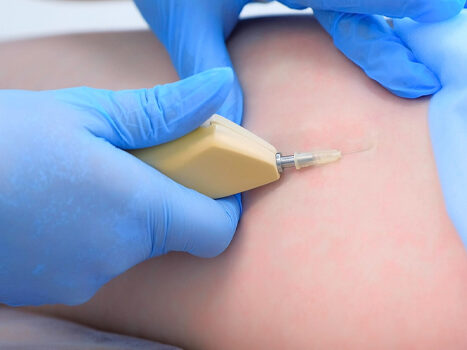What is Carboxytherapy?
Carboxytherapy is a treatment method that started in France in 1930 and is suitable for medical use, by applying carbon dioxide (CO2) gas to the subcutaneous tissue by injection method, especially for the elimination of skin problems such as cellulite and cracks. The regional application of carbon dioxide (CO2) gas into the adipose tissue creates a lipolytic that has a dissolving effect on the fatty cells. The reason for the melting effect of carbon dioxide gas in the adipose tissue is the increase in blood flow in the region. With the increase in blood flow, the amount of oxygen carried to the region increases and the destruction of fatty cells can be achieved.
In Which Areas Are Benefits From Carboxytherapy Application?
• In regional slimming (cachexia):
• In the treatment of cracks in the body due to rapid weight loss or pregnancy,
• In the treatment of cellulite,
• In the treatment of psoriasis,
• In anti-aging processes,
• In wound and scar treatment,
• Carboxytherapy is used as a beneficial method.
How is Carboxytherapy Application Performed?
In line with the expectations of the individual and the determination of the physician, the regions where the carboxytherapy application will be performed and the application plan are determined. With a process performed on a surface 3 mm deep to the skin, carbon dioxide gas is injected under the skin. With the gas absorbed by the tissue, the effect of accelerating metabolism is initiated.
How Long Does Carboxytherapy Application Take and How Many Times Is It Done?
In carboxytherapy, each session takes an average of 15 – 30 minutes. In this respect, the person can return to his daily life after this method, which is practical and can be carried out even during the lunch break.
In line with the intended treatment, desired results are achieved within an average of 10-20 sessions with 1-2 applications per week.
Is Carboxytherapy a Painful Practice?
Carboxytherapy is not a painful practice. During the application, patients generally describe the pain they feel as “a mild burning”.
Are There Any Side Effects and Risks of Carboxytherapy Application?
After the application, there may be a slight burning and a feeling of fullness in the treated area.
If the needle tip coincides with the veins, bruises may occur, albeit rare. These bruises are temporary.
Although it is performed for aesthetic purposes, it should not be forgotten that Carboxytherapy is a medical procedure and must be performed by specialist and experienced physicians. This point should be borne in mind since it constitutes an important condition both in the detection and prevention of risk factors and in the success of the application.
How Effective Is Carboxytherapy for Cellulite Treatment?
When it comes to genetic predisposition, excessive weight gain, pregnancy and unhealthy diet pave the way for cellulite formation. The attention to the nutrition of the person during and after the treatment and the applications combined with other cellulite treatment methods strengthen the success of the treatment.
Other Cellulite Treatment Methods That Can Be Applied With Carboxytherapy?
See: Mesotherapy Lipolysis
See: Pressotherapy (Lymphatic Drainage)
See: Cellulite Massage
What is the Price of Carboxytherapy Application?
Factors such as the treatment for which carboxytherapy application will be used, the area where the application will be made, the width of the application area, the number of sessions to be determined play a role in determining the price of the application. For more detailed information on the subject and to make an appointment, you can contact us at 444 57 07.


